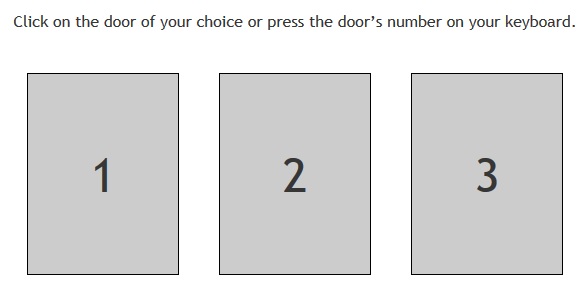Chapter 1. Monty Hall Problem
1.1 Introduction
Monty Hall Problem
Back in 1963, a show named Let’s Make a Deal premiered with Monty Hall as the host. The final part of the show featured a player from the studio audience who was given a chance to pick one of three doors to win a prize. The doors were labeled 1, 2, and 3. The interesting part is that after the player chose a door, say door 2, one of the other doors was opened, say door 3, to show that the prize was not behind that door. Then the player got the opportunity to change her choice. In this circumstance, should the player stick with his choice or switch? In this experiment, you will get a chance to try this situation out several times. See how well you can choose the door with the “prize.”
1.2 Experiment Setup

1.3 Instructions
Instructions
In the basic task, you will be presented with three doors labeled 1, 2, and 3. One of the three doors wins and the other two doors lose. Behind the winning door is the word WIN; there is nothing behind the losing doors. Your task is to pick the winning door. You pick a door by clicking on the door of your choice or by pressing the corresponding number on your keyboard. After you make your selection, one of the other two doors will be opened to show that it is a losing door. You now have the chance to stay with the same door choice or to switch your choice to the other closed door. To keep the same door, you either click that door or the button that says Stay. To choose the other closed door, either click on that door or the button that says Switch.
On some trials, before the doors are presented, you will be shown a 3 X 3 grid with four random dots in the grid. Then you will pick a door just as described above, after which you will again be presented with the 3 X 3 grid. Click on the squares where you remember the dots having been. When you are done, press the space bar to continue the experiment.
Keyboard Responses
| Key | What Response Means |
|---|---|
| 1 | Door 1 |
| 2 | Door 2 |
| 3 | Door 3 |
1.4 Experiment
Begin Experiment

1.5 Results
Results

1.6 Debriefing
Debriefing
The Monty Hall problem has become a rich field of study for how humans make decisions in two-stage problems, in which they make decisions and then are given more information.
Let us look at the problem clearly. When the experiment starts you have a 1 in 3 chance of choosing the correct door. No questions here and nothing very interesting. The interesting part of the problem occurs next, after a door is opened. What are the odds that the prize is behind either of the remaining doors? To answer this question we have to realize that it is not random which door is opened. It cannot be the door you chose and it cannot be the winning door. Use the diagram below to help think through this situation.

If you first pick door 1, then only door 2 or 3 can be opened. At the beginning, recall, each door has a 1 in 3 chance of having the prize. Let us consider what door can be opened if the prize is behind each of the three doors.
- 1/3rd of the time, the prize is behind door 2, and they have to open door 3, or the door you have not chosen initially.
- 1/3rd of the time, the prize is behind door 3, and they have to open door 2, or the door you have not chosen initially.
- 1/3rd of the time, the prize is behind the door you chose, door 1 in this case.
So, 2/3rd of the time, the prize is behind the door you have not chosen and only 1/3rd of the time is the prize is behind the door you have chosen. Your best choice is to switch your door after they open a door. You will be correct 2/3rd of the time.
The other factor in this experiment is the role of working memory in our decision making. We often do not understand the role of probability in our decisions. However, we do better if our working memory is not already working. Recall that working memory has a limited capacity. If capacity is taken up with a memory task, we have less ability to perform properly in a decision making task.
References:
De Neys, W., & Verschueren, N. (2006). Working memory capacity and a notorious brain teaser: The case of the Monty Hall dilemma. Experimental Psychology, 53(2), 123-131.
Herbranson, W. T., & Schroeder, J. (2010). Are birds smarter than mathematicians? Pigeons (Columba livia) perform optimally on a version of the Monty Hall dilemma. Journal of Comparative Psychology, 124(1), 1-13.
Jiang, Q., & Qinglin, Z. (2006). Causes of Monty Hall dilemma's difficulty. Psychological Science (China), 29(1), 222-224.
Mazur, J. E., & Kahlbaugh, P. E. (2012, May 14). Choice behavior of pigeons (Columba livia), college students, and preschool children (Homo sapiens) in the Monty Hall dilemma. Journal of Comparative Psychology. Advance online publication. doi: 10.1037/a0028273
1.7 Quiz
Quiz